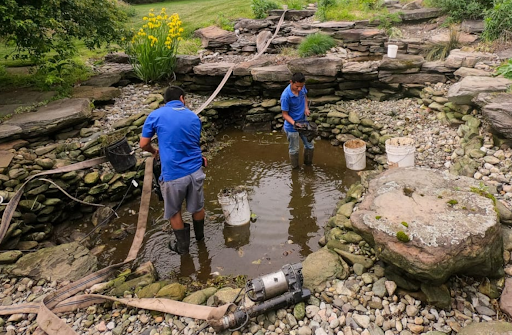The Secrets to a Cleaner Pond: Water Management and Maintenance Tips
Maintaining a cleaner pond is essential for the health of aquatic life and the long-term stability of your outdoor water feature. Pond water is never chemically static—it undergoes constant fluctuations due to environmental factors, biological processes, and human interventions. While many of these shifts are natural and harmless, unmanaged chemical changes can lead to severe consequences, including fish illness, plant decay, and bacterial imbalance.
To create and preserve a healthy, balanced environment, it’s critical to understand what affects pond chemistry and how to manage it effectively.
What Is a Cleaner Pond?
A cleaner pond refers to a well-maintained aquatic environment with minimal pollutants, optimal oxygen levels, stable pH, and a balanced nutrient load. It supports fish, plants, and beneficial microorganisms without frequent disruptions or harmful imbalances.
A truly cleaner pond isn’t just free of visible debris—it’s one where the unseen chemical makeup is consistently monitored and managed. Regular testing and maintenance ensure that key parameters remain within safe ranges, preventing ecological crashes and supporting long-term aquatic life sustainability.
Understanding Core Water Parameters
Several core chemical parameters determine the overall health of your pond. Monitoring these values regularly is the foundation of maintaining a cleaner pond:
Dissolved Oxygen (O₂)
Oxygen is vital for fish respiration and the breakdown of organic matter by aerobic bacteria. Low oxygen levels, especially in warmer months, can cause fish to gasp at the surface and lead to increased ammonia buildup.
pH (Potential of Hydrogen)
The pH scale determines how acidic or basic the pond water is. Most aquatic species thrive in a pH range between 6.5 and 8.0. Fluctuations outside of this range can stress fish and damage plants.
kH (Carbonate Hardness)
kH stabilizes pH by buffering the water against sudden changes. A higher kH means your pond is more resistant to acidification, making it easier to maintain a cleaner pond long-term.
Ammonia (NH₃)
Ammonia is toxic to fish even at low levels. It’s mainly introduced through fish waste, uneaten food, and decomposing organic material. Safe ammonia levels should be as close to 0 ppm as possible.
Nitrites (NO₂⁻) and Nitrates (NO₃⁻)
These nitrogen compounds are part of the biological filtration cycle. Nitrites are also harmful to fish, while nitrates, though less toxic, can fuel algae growth if allowed to accumulate.
Testing Tip: Use multi-parameter test kits from brands like Evolution Aqua or Tetra to gain insights into all major water chemistry factors in one go.
Main Causes of Water Chemistry Fluctuations
Knowing what triggers chemical imbalance in your pond can help you take preemptive steps toward maintaining a cleaner pond.
Rainwater Runoff
Rainwater is naturally slightly acidic due to its absorption of atmospheric carbon dioxide. In small quantities, this isn’t harmful. However, heavy or frequent rain can dilute pond water and shift the pH balance, stressing aquatic life. After every major rain event, it’s good practice to test your water and, if necessary, buffer it with a pH stabilizer.
Fertilizer Leaching
When fertilizers used in nearby gardens or lawns wash into your pond during rain, they introduce high levels of nitrates and phosphates. These nutrients may stimulate rapid algae growth, clouding the water and reducing oxygen. To avoid this, either avoid fertilizing near the pond or irrigate your garden using pond water, which naturally contains low levels of nutrients.
Overgrown Pond Plants
Aquatic plants help maintain a cleaner pond by absorbing excess nutrients and releasing oxygen during daylight. However, at night, they consume oxygen and release carbon dioxide. In heavily planted ponds, this can lead to oxygen depletion by early morning. A balanced planting strategy—roughly 50% surface coverage—is ideal. Adding aeration features like fountains or waterfalls can further stabilize oxygen levels.
Temperature Shifts
Temperature has a direct effect on dissolved oxygen and evaporation. As water warms, its ability to hold oxygen decreases. For example:
- At 27°C, dissolved oxygen = ~8 ppm (safe for fish)
- At 30°C, dissolved oxygen = ~5 ppm (too low)
To maintain a cleaner pond during hot weather, use floating plants like water lilies for shade and install aerators to increase surface agitation and oxygen exchange.
Organic Waste Accumulation
Dead plants, leaves, and uneaten fish food decompose at the bottom of the pond, forming sludge. This decomposition process releases ammonia and nitrites, disrupting water chemistry. Regular cleaning is key. Use tools like the PondXpert 4-in-1 Maintenance Set to skim debris, remove blanketweed, and vacuum sludge effectively.
Overstocking and Overfeeding Fish
Too many fish in a small pond leads to excessive waste. Overfeeding adds to the organic load, creating a toxic environment with high ammonia levels. If your filtration system can’t keep up, the nitrogen cycle breaks down, putting your pond at risk.
To support a cleaner pond, always:
- Stock fish conservatively
- Feed only what they can consume within a few minutes
- Use biological and mechanical filtration systems efficiently
Why Regular Testing Is Essential
Even if your pond looks clear, it might not be chemically stable. Monthly water testing is a cornerstone of pond health and an essential part of keeping a cleaner pond. Testing allows you to:
- Identify rising ammonia, nitrite, or nitrate levels
- Ensure consistent oxygen and pH levels
- Confirm kH and GH (general hardness) levels are stable
- Detect algae-promoting nutrients before they bloom
This data-driven approach enables prompt action before minor problems escalate into expensive or deadly ones.
Indicators of Water Quality Problems
Watch for these visual or behavioral cues that signal an unhealthy pond environment:
- Fish gasping for air near the surface
- Slow or lethargic fish movements
- Cloudy, green, or foul-smelling water
- Rapid algae blooms
- Stunted or dying pond plants
Spotting these signs early allows you to take corrective action and maintain a cleaner pond.
Tips for Cleaner Pond Maintenance
Integrating the following best practices can help you keep your pond consistently clean and balanced:
- Install a Quality Filtration System
Combine mechanical and biological filters to remove waste and support the nitrogen cycle. - Skim and Vacuum Regularly
Use tools like nets, vacuums, and pond-specific cleaning kits to reduce sludge buildup. - Introduce Beneficial Bacteria
These help accelerate the breakdown of organic waste, keeping ammonia and nitrite levels low. - Control Fish Population
Avoid overcrowding and match the number of fish to the pond’s size and filtration capacity. - Use Floating and Submerged Plants
These provide shade, consume nutrients, and help balance oxygen levels. - Aerate the Pond
Add fountains, waterfalls, or air pumps to ensure adequate oxygenation. - Limit Fertilizer Use Nearby
Prevent chemical runoff by maintaining a buffer zone around the pond.
Clearing Up Confusion
How often should I test pond water?
Ideally, you should test water parameters once a month. During hot weather or after major events like heavy rain, test more frequently.
Can a pond be too clean?
Yes. Over-cleaning or sterilizing a pond can remove beneficial bacteria and natural balances. Aim for clean, not sterile.
What temperature is too hot for pond fish?
Most pond fish become stressed at temperatures above 30°C. Use shade and aeration to help regulate temperature.
Is green water always a bad sign?
Green water often signals excess nutrients. While it isn’t always dangerous, it usually indicates poor water balance and can lead to oxygen drops.
Do plants help with pond cleaning?
Absolutely. Plants absorb excess nutrients and improve oxygen levels, contributing significantly to a cleaner pond.
Final Thoughts
Maintaining a cleaner pond requires both commitment and knowledge. Natural processes will always introduce variables into your pond’s chemistry, but with regular testing, timely cleaning, and thoughtful design, you can manage those changes successfully. A well-maintained pond isn’t just beautiful—it’s a healthy, functioning ecosystem where aquatic life can thrive.
Keep an eye for more latest news & updates on Qiuzziz!





